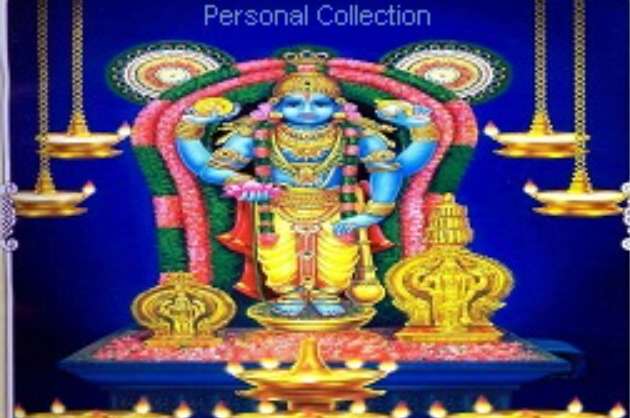Anupama Nair
I am writing a topic close to my heart i.e., about my Giridhara Gopala. It is the grace of the Lord that we have managed to survive the pandemic. If you and your family is safe from Corona for more than a year, it is the blessing of the Lord. “Faith can move mountains”. This is what my grandmother always used to tell me. My belief in her old words of wisdom was reinstated whenever I visit the temples of my Lord Krishna. In the last part I spoke about the life of the Lord. Today I will complete the story and tell you about Guruvayur.
It was Bhima, the second Pandava (son of Kunti, sister of Vasudev), his cousin who killed Jarasandha but Kalyavan followed the Lord to Dwarka to kill him. Krishna now acted like running away from him and ran into a cave in which King Muchukunda was sleeping. The King had got a boon from Devas that whoever woke him up would be burned into ashes. Kalyavan mistook the sleeping King for Krishna and woke him up. He met his end when he was turned into ashes.
The Kingdom of Dwaraka came to an end due to the curse of Gandhari, the mother of Duryodhana after the Kurukshetra War. She shouted at Krishna as to why, in spite of her being his staunch devotee, and Pandavas and Kauravas, being created and sustained by Lord Krishna himself, he let the debacle happen. Why couldn't he have averted the war itself? On seeing, his all-knowing smile even at such a time, she cursed the entire Yadava family to be killed in the next 36 years and Krishna himself to be killed. Sri Krishna granted her curse to come true. Krishna returned to Dwaraka and took good care of his subjects. During this time, the Yadavas attained wealth and prosperity. The Yadavas were considered to be quarrelsome people and in the lap of luxury, they lost their morals and humility. Soon after a fight took place between Yadavas and all were killed except Daruka, Balarama and Krishna. The city created by the Lord is now under the sea.
Krishna started thinking about the ways and means to attain samadhi and for Gandhari’s curse to be true. He remembered the words of Rishi Durvasa. Long time ago as per the wish of saint Durvasa, he applied Payasam (liquid food prepared with milk, sugar and rice) throughout the Rishi’s body. As his legs were resting on the ground, he could not apply it to his feet. Durvasa observed it and said: “Krishna! You have not applied Payasam to my foot. Your death is in your foot.” Many years later, Lord Krishna was lying down under a tree and went into Yoga Samadhi. At that time a hunter Jara entered that forest. He thought, the moving foot of Krishna as a deer and shot a lethal arrow that pierced into Krishna’s feet. As soon as the hunter reached Krishna, he realized his mistake and pleaded the Lord for forgiveness. Lord Krishna consoled him and told him how his death was inevitable. Some believe that Jara was the Vanara King of Kishkinda, Bali in his previous birth. The previous incarnation of Lord Vishnu, Sri Ram killed Bali hiding behind a tree. Bali cursed him and said “in your next birth, I will kill you similarly”. So, the two curses came true. The lesson we learn is be it, god or human, curses might come true.
Now let me tell you about Guruvayur, a pilgrimage town in Kerala. It’s famous for the centuries-old, red-roofed Guruvayur Temple. The presiding deity of the Guruvayur Temple is Guruvayurappan and is often referred to as “ Bhulokha Vaikunda” or the “holy abode of Vishnu on Earth”. We can see a four-armed standing Lord Vishnu, carrying his conch Panchajanya, the discus Sudarshan Chakra, the mace Kaumodaki, a lotus with a mala or garland of Tulsi. This was the image of the majestic form of the Lord revealed to Krishna's parents Vasudev and Devaki around the time of Krishna's birth. Even today the Lord is worshipped as per the laws laid down by the great saint Adi Shankaracharya.
Even today strict dress code existed for people who wish to enter the Guruvayur Temple. Men are to wear dhoti around their waist, without any dress covering their chest, but can cover the chest with a small piece of cloth called Vashti. Girls and women are prohibited from wearing any trouser-like dresses or short skirts. Women are allowed to wear sarees and girls can wear lehngas or pavada. However, the dress code for women has been relaxed with kurta-pajama being allowed.
Guruvayur is famous for Anakotta (Elephant Yard ), and has 56 elephants today. An anakotta is the home of the largest population of male Asian elephants in the world. These elephants are donated by devotees to the temple and kept in a compound close to the temple. However, as more and more devotees donated elephants, the space became insufficient and hence they were moved to a larger property. The devotees consider these elephants as the form of the Lord. Guruvayur Keshavan and Padmanabhan were the most loved among all the elephants.
The deity of the temple is more than 5000 years old. It is believed that in the 14th century, a Tamil book called “Kokasandesam” there are references to a place called Kuruvayur. In the 16th century there are many references to Kuruvayur. In ancient Tamil, kuruvai means sea, hence the village on the Malabar Coast could be called Kuruvayur. The earliest mention of the many important Vishnu temples of Kerala are found in the songs of Alwars, and through Mamankam (a very famous local event at Tirunavaya). There were many battles in Calicut fought by the rulers called Zamorins and people of Valluvanad . Due to these prolonged battles, people across the riverbank started preferring Guruvayur. Later, even the Zamorin become a devotee and there are references to a place called Kuruvayur made by his subjects.
In the next part, I will talk about the legends of the city and how this holy city began to be called Guruvayoor.
(To be continued…)





























Fills me with devotion
Fills me with devotion
Must visit this temple once it opens.
Must visit this temple once it opens.
Jai Shree Krishna
Jai shree krishna
Jai shree krishna
Jai shree krishna